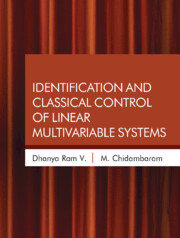Book contents
- Frontmatter
- Contents
- Preface
- Acknowledgements
- List of Abbreviations
- Notations
- 1 Models, Control Theory, and Examples
- 2 Identification and Control of SISO Systems
- 3 Introduction to Linear Multivariable Systems
- 4 CRC Method for Identifying TITO Systems
- 5 CRC Method for Identifying SISO Systems by CSOPTD Models
- 6 CRC Method for Identifying TITO Systems by CSOPTD Models
- 7 Identification of StableMIMO System by Optimization Method
- 8 Identification of Centralized ControlledMultivariable Systems
- 9 Identification of Multivariable SOPTD Models by Optimization Method
- 10 Identification of Unstable TITO Systems by Optimization Technique
- 11 Centralized PI Controllers Based on Steady State Gain Matrix
- 12 SSGM Identification and Control of Unstable Multivariable Systems
- 13 Control of Stable Non-square MIMO Systems
- 14 Control of Unstable Non-square Systems
- 15 Trends in Control ofMultivariable Systems
- Appendix A Identification of Unstable Second Order Transfer Function Model with a Zero by Optimization Method
- Appendix B For Chapter 3
- Appendix C For Chapter 7
- Bibliography
- Index
8 - Identification of Centralized ControlledMultivariable Systems
Published online by Cambridge University Press: 31 July 2022
- Frontmatter
- Contents
- Preface
- Acknowledgements
- List of Abbreviations
- Notations
- 1 Models, Control Theory, and Examples
- 2 Identification and Control of SISO Systems
- 3 Introduction to Linear Multivariable Systems
- 4 CRC Method for Identifying TITO Systems
- 5 CRC Method for Identifying SISO Systems by CSOPTD Models
- 6 CRC Method for Identifying TITO Systems by CSOPTD Models
- 7 Identification of StableMIMO System by Optimization Method
- 8 Identification of Centralized ControlledMultivariable Systems
- 9 Identification of Multivariable SOPTD Models by Optimization Method
- 10 Identification of Unstable TITO Systems by Optimization Technique
- 11 Centralized PI Controllers Based on Steady State Gain Matrix
- 12 SSGM Identification and Control of Unstable Multivariable Systems
- 13 Control of Stable Non-square MIMO Systems
- 14 Control of Unstable Non-square Systems
- 15 Trends in Control ofMultivariable Systems
- Appendix A Identification of Unstable Second Order Transfer Function Model with a Zero by Optimization Method
- Appendix B For Chapter 3
- Appendix C For Chapter 7
- Bibliography
- Index
Summary
For systems with significant interactions, a centralized control system is preferred over a decentralized control system. The closed loop identification of model parameters of FOPTD models of a multivariable system under the control of centralized PI control system is carried out by an optimizationmethod. Themethod of getting the initial guess values of the model parameters is given. The closed loop performances of the original system are compared with the closed loop of the identified model with the same centralized controllers.
Identification Method
The method used here is basically the one proposed in the previous chapter wherein the control system was a decentralized control system whereas in the present work a centralized PI control system is considered. Let G(s) and Gc(s) be the transfer function matrix (of size n × n) for the process and the centralized control system as given in Eq. (8.1) and Eq. (8.2).
Here i = 1, 2, … ,N and j = 1, 2, … ,N. The block diagram in Fig. 3.3 (Chapter 3) shows a centralized TITO multivariable system. The process transfer function models are given by FOPTD model as in Eq. (8.3).
With a suitable set of the controller parameters, the closed loop system gives a stable response. A unit step change is introduced in the set point yr1. The main response y11 and the interaction response y21 are obtained. Similarly, a unit step change is given separately to yr2 and the main response y22 and the interaction response y12 are obtained. Thus, we have Eq. (8.4).
The guess values for the model parameters can be obtained from the response matrix. Let us consider the proposedmethod for the calculation of the guess values for the centralized control system of a TITO system. The guess value for kpii is considered as 1/kcii. The guess values of the interaction gains (kp21 and kp12) are to be calculated. The method given in the previous chapter is suitably modified. The Laplace transforms of interaction response y21(s⋆) and y12(s⋆) are given by the expression by Rajapandiyan and Chidambaram (2012a) and Wang et al. (2008) as in Eq. (8.5) and Eq. (8.6)
- Type
- Chapter
- Information
- Publisher: Cambridge University PressPrint publication year: 2023



